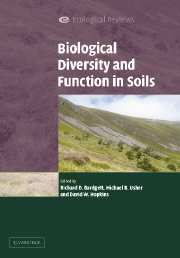Book contents
- Frontmatter
- Contents
- List of contributors
- Preface
- Acknowledgements
- PART I Introduction
- PART II The soil environment
- PART III Patterns and drivers of soil biodiversity
- PART IV Consequences of soil biodiversity
- PART V Applications of soil biodiversity
- 16 Soil biodiversity in rapidly changing tropical landscapes: scaling down and scaling up
- 17 Restoration ecology and the role of soil biodiversity
- 18 Soil biodiversity: stress and change in grasslands under restoration succession
- 19 Soil biodiversity, nature conservation and sustainability
- PART VI Conclusion
- Index
- References
19 - Soil biodiversity, nature conservation and sustainability
Published online by Cambridge University Press: 17 September 2009
- Frontmatter
- Contents
- List of contributors
- Preface
- Acknowledgements
- PART I Introduction
- PART II The soil environment
- PART III Patterns and drivers of soil biodiversity
- PART IV Consequences of soil biodiversity
- PART V Applications of soil biodiversity
- 16 Soil biodiversity in rapidly changing tropical landscapes: scaling down and scaling up
- 17 Restoration ecology and the role of soil biodiversity
- 18 Soil biodiversity: stress and change in grasslands under restoration succession
- 19 Soil biodiversity, nature conservation and sustainability
- PART VI Conclusion
- Index
- References
Summary
SUMMARY
Soils have hardly featured in nature conservation thinking. Criteria have been developed for selecting networks of important Earth science sites, but these have not included criteria for soils.
Above ground, nature conservation has focused on communities of plants and the animals that they support, and criteria have been developed for selecting the ‘best’ sites. There has been scant attention to the soils on which those plant communities depend.
Although species rich, soils do not contain the charismatic species that have been favoured by conservationists. There is no giant panda, corncrake or lady's slipper orchid.
Both the increasing concentration on biodiversity and ‘the ecosystem approach’ are shifting thinking in relation to soils. Despite limited taxonomic knowledge, some attention is being paid to fungi (e.g. the waxcaps, Hygrocybe spp.) and the larger soil-inhabiting invertebrates (e.g. the mole cricket, Gryllotalpa gryllotalpa, and earthworms). The ‘ecosystem approach’ is forcing a more holistic view, focusing on the function of terrestrial ecosystems.
Soils are intimately involved in many ecosystem processes that contribute to the sustainable use of the planet's land resources. The contribution of soils and their biota to sustainable development will ultimately be far more important than the protection of either individual soil types or individual species.
Introduction
Although it is true that nature conservationists have generally neglected soils, there is one notable exception, that relating to peat soils (e.g. Heathwaite & Göttlich 1990).
- Type
- Chapter
- Information
- Biological Diversity and Function in Soils , pp. 363 - 378Publisher: Cambridge University PressPrint publication year: 2005
References
- 3
- Cited by



